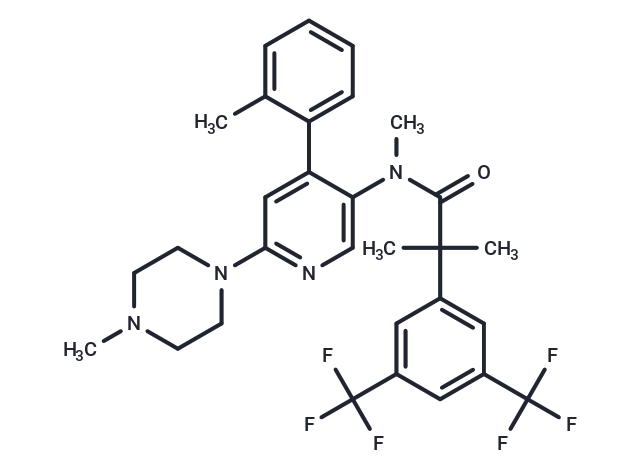Shopping Cart
Remove All Your shopping cart is currently empty
Your shopping cart is currently empty
Netupitant (CID 6451149) is a specific neurokinin 1 (NK1) receptor antagonist (Ki: 0.95 nM).

| Pack Size | Price | USA Warehouse | Global Warehouse | Quantity |
|---|---|---|---|---|
| 5 mg | $47 | In Stock | In Stock | |
| 10 mg | $68 | In Stock | In Stock | |
| 25 mg | $122 | In Stock | In Stock | |
| 50 mg | $210 | In Stock | In Stock | |
| 100 mg | $378 | In Stock | In Stock | |
| 200 mg | $558 | In Stock | In Stock | |
| 500 mg | $886 | In Stock | In Stock |
| Description | Netupitant (CID 6451149) is a specific neurokinin 1 (NK1) receptor antagonist (Ki: 0.95 nM). |
| Targets&IC50 | NK1:0.95 nM(Ki) |
| In vitro | Netupitant concentration-dependently antagonizes the stimulatory effects of substance P (SP) in CHO NK1 cells and shows insurmountable antagonism (pKb: 8.87). In cells expressing NK2/3 receptors, Netupitant is inactive. |
| In vivo | In mice the intrathecal injection of SP elicited the typical scratching, biting and licking response is dose-dependently inhibited by Netupitant (1-10 mg/kg, i.p.). In gerbils, foot tapping behavior evoked by the intracerebroventricular injection of an NK1 agonist is dose-dependently counteracted by Netupitant gave intraperitoneally (ID50 1.5 mg/kg) or orally (ID50 0.5 mg/kg). In time course experiments in gerbils, Netupitant displayed long-lasting effects. |
| Kinase Assay | zotarolimus (10 pM-1 μM) in buffer A (2% BSA and 0.2% Tween-20 in D-PBS) is used in the assay of Binding Affinity to FKBP12. |
| Cell Research | Cell lines: NG108-15 cells. Concentrations: 1,3,10,30 nM. Method:cells are preincubated for 1 h at 37℃ with either growth media alone(control) or media containing antagonists.Antagonist concentrations are at least 30-fold the Kd value to ensure receptor saturation.After preincubation,antagonists are removed and cells are rinsed with growth media alone for an additional hour to allow for dissociation of antagonists still bound to the receptor.Cell media are then replaced with isosmotic HEPES buffer (pH 7.4,20 mM) containing NaCl (130 mM),KCl (2 mM),MgCl2 (1 mM) CaCl2 (2 mM),Fluo-4 acetoxymethyl (AM) ester (2 mM),pluronic acid (0.04%) and SP at various concentrations in the 3 nM to 1 mM range.The final incubation lasted for 1 h at 37 ℃.Pluronic acid is added as a nonionic surfactant to sequester the AM ester molecules into micelles for cellular uptake. |
| Animal Research | Animal Models: Male Swiss mice. Formulation: Saline containing 5% DMSO and 5% Tween 80. Dosages: 1 and 10 mg/kg. Administration: i.p. |
| Synonyms | Ro 67-31898/000, CID 6451149 |
| Molecular Weight | 578.59 |
| Formula | C30H32F6N4O |
| Cas No. | 290297-26-6 |
| Smiles | CN(C(=O)C(C)(C)c1cc(cc(c1)C(F)(F)F)C(F)(F)F)c1cnc(cc1-c1ccccc1C)N1CCN(C)CC1 |
| Relative Density. | 1.255 |
| Storage | Powder: -20°C for 3 years | In solvent: -80°C for 1 year | Shipping with blue ice/Shipping at ambient temperature. | ||||||||||||||||||||
| Solubility Information | DMSO: 9.62 mg/mL (16.63 mM), Sonication is recommended. | ||||||||||||||||||||
Solution Preparation Table | |||||||||||||||||||||
DMSO
| |||||||||||||||||||||
| Size | Quantity | Unit Price | Amount | Operation |
|---|

Copyright © 2015-2025 TargetMol Chemicals Inc. All Rights Reserved.